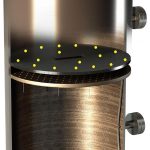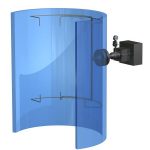Refinery environments often present daunting challenges for the measuring equipment. Not only the harsh conditions in which the equipment is used are frequently problematic; expectations regarding safety, cost effectiveness and product quality are also steadily increasing. The flexible multipoint thermocouple reflects this trend and is meanwhile established as the standard for a variety of temperature measurement applications in refineries.
Authors Robert Torgerson Director of Technology, Global Accounts, Global Center of Excellence, Gayesco International Kai Grabenauer Product Manager CoE Europe; Electrical temperature measurement, Wika
Let’s take a brief look back to the mid-eighties: nearly a decade after the oil crisis, the petrochemical industry is under considerable economic pressure. Refiners are struggling to get the optimum performance out of their plants. The decision by a growing number to upgrade their reactors with a new generation of highly active catalysts appears only logical.
After all, these catalysts offer better selectivity and conversion rates and hence raise productivity and profitability levels. At the same time, however, they prompt new concerns among refiners: in hydrocracking plants, higher-activity catalysts can result in a quicker reaction. One consequence of these exothermic processes is the situation commonly referred to as a thermal excursion or runaway. Runaway can be dangerous if detected too late, as sudden temperature rises may exceed the metallurgical limits of the vessel wall, resulting in a catastrophic failure and loss of containment.
This was the measurement challenge confronting the straight multipoint thermometers with pipewell prevalent in industrial applications thirty years ago. Unfortunately, though, their conventional type of construction was only of limited suitability for monitoring the temperature in reactors equipped with the new catalyst generation. There were three main reasons for this shortcoming:
- Response time: The pipewell was specified for the high pressure environment in hydrocrackers and hydrotreaters. On the other hand, the thick metal wall of the tube slowed down the thermometer’s response time, meaning it would react too late to a runaway situation in the vessel.
- Channelling: This negative effect was observed along the pipewell, which was usually installed vertically. The process medium flowed through the reactor faster, like in a channel, and the catalyst no longer had sufficient time to convert the product.
- Limited point location: The sensing points were inadequately distributed. They were restricted to the linear geometry of the pipewell, leaving a significant part of the reactor without thermometry. There was a risk that missing hotspots would lead to reduced catalyst life and / or a temperature excursion.
Flexible thermocouple systems
Responding to these complex requirements, Gayesco (today a company of the Wika Group) set out to design flexible thermocouple systems. These have been regularly adapted to the changing requirements of the petrochemical industry ever since and are used in a variety of applications in single-bed and multibed reactors under the Flex-R label.
The operating principle was the outcome of close cooperation with process engineers, users and licensors: a specially designed, mineral insulated and hence extremely durable sheathed cable not only replaced the pipewell but also allowed the sensing points to be freely configured. The result was a radial system for measuring temperature profiles with a very short response time of about 4 to 8 s (rather than 3 min, as was the case with conventional pipewells). The operator consequently had plenty of time to react to potential runaway conditions and take appropriate counteraction. The system provided the higher point density that had previously been lacking.
These tip-sensitive thermocouples are installed in the reactor using special fixation systems, so that only a tiny footprint remains in the process flow.
Flex-R thermometers are either flanged to the reactor or secured to it with a high pressure screw connection (Radial Tap) if space is an issue. Once installed, they can be handled without any major problems for the process, further aiding refiners‘ efforts to cut costs. The measuring system remains inside the vessel if the catalyst is dumped during turnaround, for instance. Service technicians can calibrate the thermocouple on site or repair the MI cable if the sheath is damaged when the catalyst is emptied.
In the years that followed, more flexible multipoint thermometers were developed alongside the Flex-R. The majority of these models, where other manufacturers attempted to emulate the functionality of the Gayesco system, had a linear geometry with several sensing points in a single sheath. They were suited as affordable solutions for recording linear temperature gradients.
Owing to their complex internal structure with multiple sensing points in one sheath, however, there were no safety functions and on-site repairs proved to be impossible. If ever the outer sheath was damaged, the operator was robbed of all sensing points at once.
Wide range of applications
Just how stably the Flex-R system works was demonstrated by the first multipoint thermometer in this series, which was installed by Gayesco in the reactor of the Shell refinery in Woodriver (Illinois) in 1988. All 260 sensing points, located on several different levels of the catalyst beds, have been functioning for the past twenty-six years without a hitch and not a single failure, even though the catalyst has been dumped on a number of occasions.
The benefits of radial temperature measurement in a reactor extend far beyond the ability to detect hotspots – originally the main objective of the new measuring system. These same instruments simultaneously provide information on catalyst maldistribution inside the vessel and support remaining life predictions. Flexible multipoint thermometers can additionally be used for top-of-bed performance evaluations.
It soon became evident that the multipoint so-lution developed by Gayesco had a great potential range of applications within the refinery. Amongst other things, it can be employed to monitor the catalyst in phenylethylene processes and distillation columns, control catalyst regeneration in reforming units (FCR) or measure the temperature in diplegs and cyclones during fluid catalytic cracking (FCC).
For several years now, increased regulatory requirements for emissions have been implemented worldwide with corresponding impacts on fuel quality and cleanliness – particularly the sulphur content. In response to these industry needs there has been a dramatic rise in the number of flexible multipoint thermometers in hydrocrackers and hydrotreaters. Unfortunately, the high density of measuring equipment in the reactor has tended to be detrimental to the flow rate and distribution of the process medium and hence also to the quality of the fuel – the end product. In order to reduce the negative repercussions for the reaction processes to a minimum, Gayesco developed special low-profile supports for the multipoint thermometers concerned. These are combined with the company’s own know-how regarding the optimal routing of the thermocouples in the reactor.
The efforts by R&D engineers to improve multipoint thermometers for radial temperature measurement are still continuing. State-of-the-art multipoint thermometers use primary and secondary safety systems on the thermocouple. They also include a safety seal chamber that can optionally be monitored – in case one of the above systems happens to break. Additional sealing devices for thermocouple transitions are standard at Gayesco. Since the thermocouple size can vary with the application, durability continues to be an important concern. Specially engineered MI thermocouple cables are therefore preferred to off-the-shelf (standard) alternatives.
cpp-net.com/0314401
Share:









